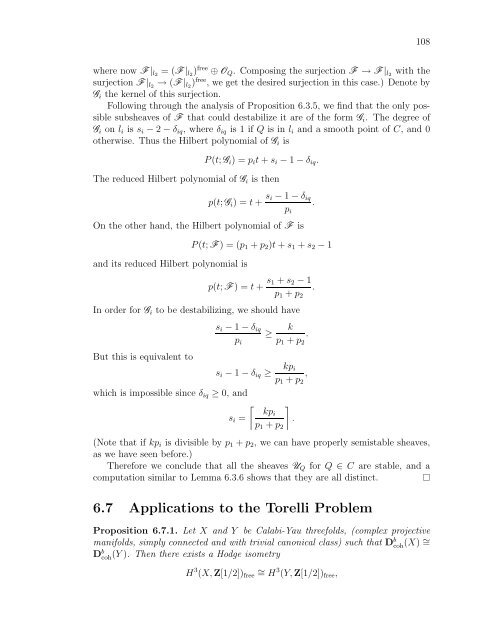derived categories of twisted sheaves on calabi-yau manifolds
derived categories of twisted sheaves on calabi-yau manifolds
derived categories of twisted sheaves on calabi-yau manifolds
Create successful ePaper yourself
Turn your PDF publications into a flip-book with our unique Google optimized e-Paper software.
108<br />
where now F |l2 = (F |l2) free ⊕ OQ. Composing the surjecti<strong>on</strong> F → F |l2 with the<br />
surjecti<strong>on</strong> F |l2 → (F |l2) free , we get the desired surjecti<strong>on</strong> in this case.) Denote by<br />
Gi the kernel <str<strong>on</strong>g>of</str<strong>on</strong>g> this surjecti<strong>on</strong>.<br />
Following through the analysis <str<strong>on</strong>g>of</str<strong>on</strong>g> Propositi<strong>on</strong> 6.3.5, we find that the <strong>on</strong>ly possible<br />
sub<str<strong>on</strong>g>sheaves</str<strong>on</strong>g> <str<strong>on</strong>g>of</str<strong>on</strong>g> F that could destabilize it are <str<strong>on</strong>g>of</str<strong>on</strong>g> the form Gi. The degree <str<strong>on</strong>g>of</str<strong>on</strong>g><br />
Gi <strong>on</strong> li is si − 2 − δiq, where δiq is 1 if Q is in li and a smooth point <str<strong>on</strong>g>of</str<strong>on</strong>g> C, and 0<br />
otherwise. Thus the Hilbert polynomial <str<strong>on</strong>g>of</str<strong>on</strong>g> Gi is<br />
P (t; Gi) = pit + si − 1 − δiq.<br />
The reduced Hilbert polynomial <str<strong>on</strong>g>of</str<strong>on</strong>g> Gi is then<br />
p(t; Gi) = t + si − 1 − δiq<br />
.<br />
On the other hand, the Hilbert polynomial <str<strong>on</strong>g>of</str<strong>on</strong>g> F is<br />
and its reduced Hilbert polynomial is<br />
pi<br />
P (t; F ) = (p1 + p2)t + s1 + s2 − 1<br />
p(t; F ) = t + s1 + s2 − 1<br />
.<br />
p1 + p2<br />
In order for Gi to be destabilizing, we should have<br />
But this is equivalent to<br />
si − 1 − δiq<br />
pi<br />
≥<br />
k<br />
p1 + p2<br />
si − 1 − δiq ≥ kpi<br />
which is impossible since δiq ≥ 0, and<br />
<br />
kpi<br />
si =<br />
p1 + p2<br />
p1 + p2<br />
(Note that if kpi is divisible by p1 + p2, we can have properly semistable <str<strong>on</strong>g>sheaves</str<strong>on</strong>g>,<br />
as we have seen before.)<br />
Therefore we c<strong>on</strong>clude that all the <str<strong>on</strong>g>sheaves</str<strong>on</strong>g> UQ for Q ∈ C are stable, and a<br />
computati<strong>on</strong> similar to Lemma 6.3.6 shows that they are all distinct.<br />
6.7 Applicati<strong>on</strong>s to the Torelli Problem<br />
Propositi<strong>on</strong> 6.7.1. Let X and Y be Calabi-Yau threefolds, (complex projective<br />
<strong>manifolds</strong>, simply c<strong>on</strong>nected and with trivial can<strong>on</strong>ical class) such that Db coh (X) ∼ =<br />
Db coh (Y ). Then there exists a Hodge isometry<br />
<br />
.<br />
H 3 (X, Z[1/2])free ∼ = H 3 (Y, Z[1/2])free,<br />
.<br />
,
















